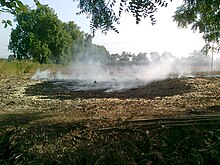| This article needs additional citations for verification. Please help improve this article by adding citations to reliable sources. Unsourced material may be challenged and removed. Find sources: "Crop destruction" – news · newspapers · books · scholar · JSTOR (December 2024) (Learn how and when to remove this message) |

Crop destruction is the deliberate destruction of crops or agricultural products to render it useless for consumption or processing. It can be made by burning, grinding, dumping into water, or application of chemicals. It should not be confused with crop residue burning, which burns non-edible parts of the crop.
Related to crop destruction is alternate, low-price use of agricultural products. A large portion of the European Union wine surplus has been converted to industrial ethanol.
There can be numerous reasons for crop destruction. In a scorched-earth strategy, crops and other useful materials are destroyed to prevent the enemy from gaining hold of them. The strategy of destroying the food supply of the civilian population in an area of conflict has been banned under Article 54 of Protocol I of the 1977 Geneva Conventions, though it continues to be used as a weapon of war.
In government-regulated agriculture, farmers can be required to destroy crops that exceed their production quota. Crops can also be dumped in the street during a public protest; this custom has been common in the European Union. Also, illegal crops, such as opium and cannabis, can be destroyed by law enforcement.
Note that this term does not apply to the burning of crops which are or can be usefully harvested by this means, such as sugar cane.
In culture
The Grapes of Wrath by John Steinbeck depicts the destruction of oranges, potatoes, pig carcasses and other agricultural products during the Great Depression.
See also
- Agent Orange – Herbicide used by the US in the Vietnam War
- Burning money – Deliberate burning of money for effectPages displaying short descriptions of redirect targets
- Crop circle – Pattern in a crop field
- Parable of the broken window – Parable by French economist Frédéric Bastiat
- Running through fields of wheat – 2017 quote by Theresa May
- Thinning – Removal of some plants to improve the growth of other plants
- War on Drugs § Aerial herbicide application
References
- "Protocol Additional to the Geneva Conventions of 12 August 1949, and relating to the Protection of Victims of International Armed Conflicts (Protocol I), 8 June 1977". ihl-databases.icrc.org. Retrieved 2024-12-01.
- Haddad, Mohammed. "How Israel destroyed Gaza's ability to feed itself". Al Jazeera. Retrieved 2024-12-01.
- Tabrizy, Nilo; Piper, Imogen; Berger, Miriam (2024-05-03). "Israel's offensive is destroying Gaza's ability to grow its own food". The Washington Post. Retrieved 2024-12-01.
- Chen, Bin; Tu, Ying; An, Jiafu; Wu, Shengbiao; Lin, Chen; Gong, Peng (2024-06-18). "Quantification of losses in agriculture production in eastern Ukraine due to the Russia-Ukraine war". Communications Earth & Environment. 5 (1): 1–10. doi:10.1038/s43247-024-01488-3. ISSN 2662-4435.
- "'The Saddest, Bitterest Thing of All.' From the Great Depression to Today, a Long History of Food Destruction in the Face of Hunger". History News Network. 2020-05-28. Retrieved 2024-12-01.
This agriculture article is a stub. You can help Misplaced Pages by expanding it. |